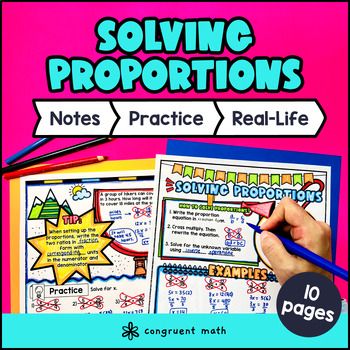Want more ideas and freebies?
Get my free resource library with digital & print activities—plus tips over email.
Join for Free Resources →
$4.25
Ever wondered how to teach solving proportions and proportional relationships in an engaging way to your 7th and 8th grade students?
In this lesson plan, students will learn about solving proportions using cross product and their real-life applications. Through artistic, interactive guided notes, check for understanding, a practice coloring worksheet, and a maze worksheet, students will gain a comprehensive understanding of solving proportions.
The lesson culminates with a real-life application activity, where students will read and write about real-life uses of solving proportions. This activity helps students see the relevance and applicability of the math skill in the world around them.

$4.25
After this lesson, students will be able to:
Before this lesson, students should be familiar with:
As a hook, ask students why it is important to understand and solve proportions in real-life situations. Refer to the last page of the guided notes as well as the FAQs below for ideas.
Use the first page of the guided notes to introduce the concept of solving proportions using cross multiplication. Walk through the steps of cross multiplication and explain how it can be used to solve proportions. Emphasize the importance of setting up the proportion correctly and cross multiplying, then isolating the variable to find the missing value.
Based on student responses, reteach the concept of cross multiplication and solving proportions if needed. Provide additional examples and guide students through the process until they can confidently solve proportions using cross multiplication.
Have students practice solving proportions using cross multiplication using the practice worksheets provided in the resource. Students can practice using page 2 (word problems) and page 3 (maze activity). Walk around the classroom to answer any questions students may have.
Fast finishers can dive into page 4 (color by number activity) for extra practice. You can assign it as homework for the remainder of the class.
Use the last page of the guided notes (real life applications) to bring the class back together, and introduce the concept of real-life applications of solving proportions and proportional relationships. Explain to the students that proportions can be used to solve a variety of real-world problems, where there is a direct relationship between two quantities.
Examples of real-life applications of proportion include:
These are just a few examples of real-life applications of solving proportions and proportional relationships. Refer to the FAQ for more ideas on how to teach it!
If you’re looking for digital practice for solving proportions and proportional relationships, try my Pixel Art activities in Google Sheets. Every answer is automatically checked, and correct answers unlock parts of a mystery picture. It’s incredibly fun, and a powerful tool for differentiation.
Here are a few activities to explore:
A fun, no-prep way to practice solving proportions and proportional relationships is Doodle Math — they’re a fresh take on color by number or color by code. It includes multiple levels of practice, perfect for a review day or sub plan.
Here are a few activities to try:
A fun way to wrap this lesson with your students is with one of my real-life math projects. They enable students to see the application of the math in an engaging, extended project:
This activity is NOT AN OFFICIAL MINECRAFT PRODUCT. NOT APPROVED BY OR ASSOCIATED WITH MOJANG.
A proportion is a statement that two ratios are equal. It compares two ratios or rates and shows their relationship.
To solve a proportion, you can use a method called cross multiplication. Cross multiplication involves multiplying the numerator of one ratio by the denominator of the other ratio and setting the products equal to each other.
Cross multiplication is a method used to solve a proportion. It involves multiplying the numerator of one ratio by the denominator of the other ratio and setting the products equal to each other.
Sure! Let's say we have the proportion 3/4 = x/12. To solve for x, we can cross multiply: 3 * 12 = 4 * x. This simplifies to 36 = 4x. Then, divide both sides by 4 to find x: x = 9.
Yes, there are alternative methods to solve proportions, such as using equivalent fractions or using the unitary method. However, cross multiplication is a commonly used and efficient method.
Yes, proportions can be solved with variables. This allows us to find an unknown value or to express a relationship between variables.
Proportions are used in various real-life situations, such as cooking measurements, scaling up or down recipes, calculating discounts or sales tax, and solving problems involving distance, time, and speed.
Yes, after solving a proportion, you can check your work by substituting the values back into the original proportion and verifying that both sides are equal.
Yes, this lesson plan is suitable for both 7th grade and 8th grade students. It aligns with Common Core Standards for both grade levels and provides guided notes and practice worksheets to support students' understanding of solving proportions and proportional relationships.
Get my free resource library with digital & print activities—plus tips over email.
Join for Free Resources →